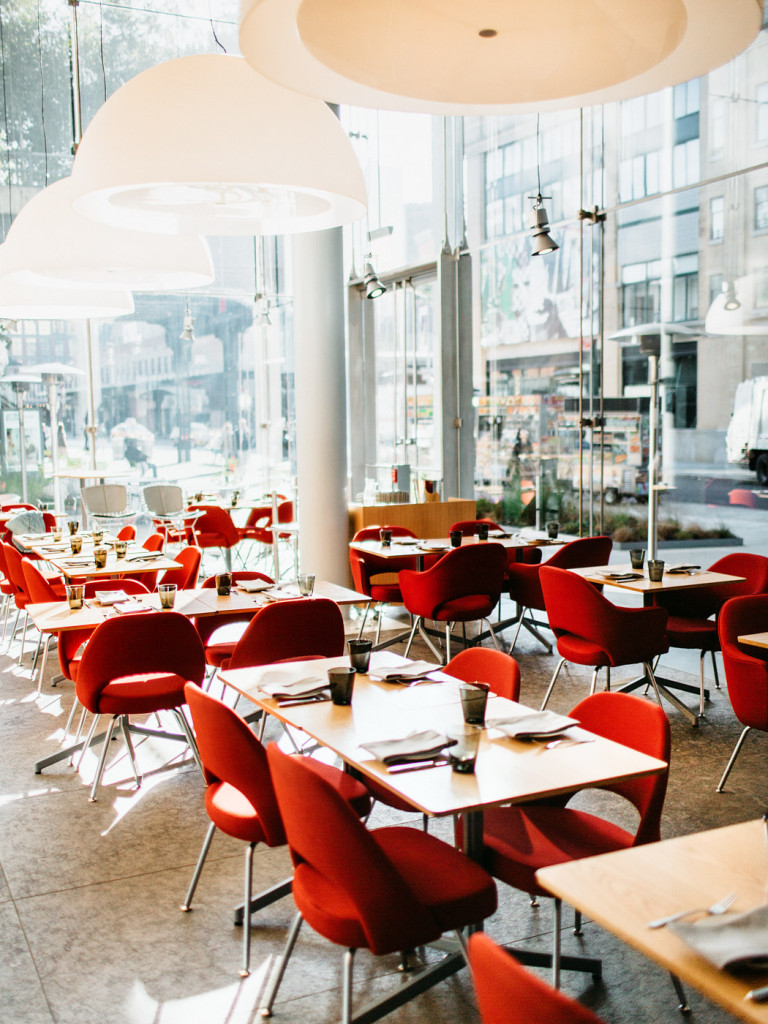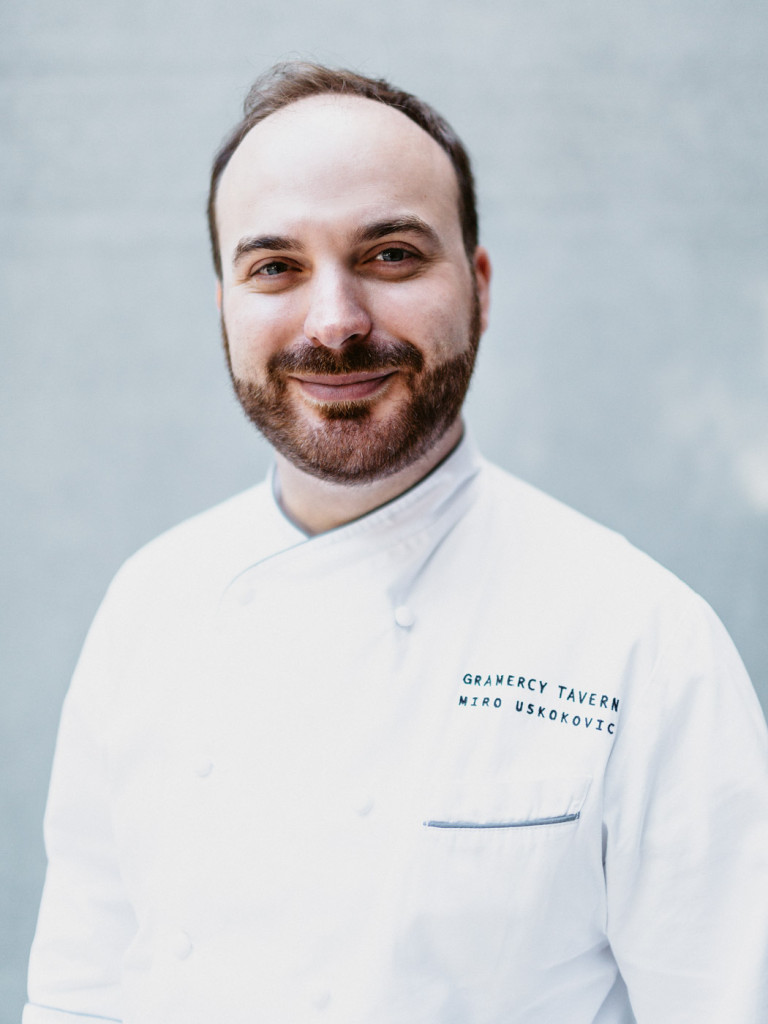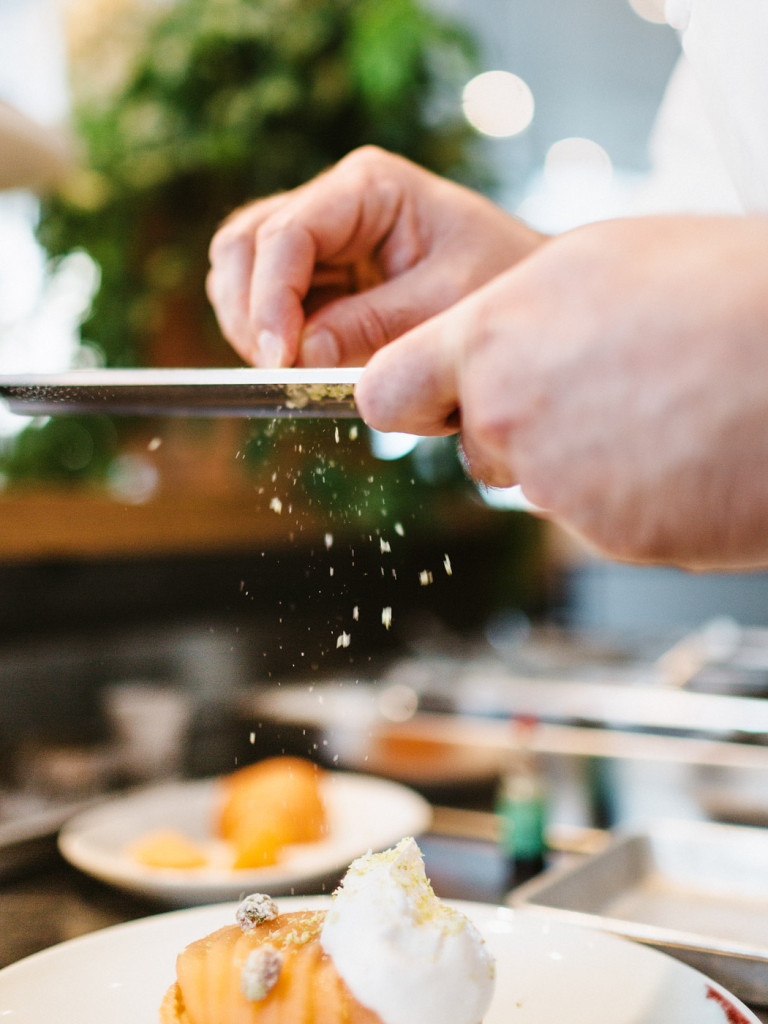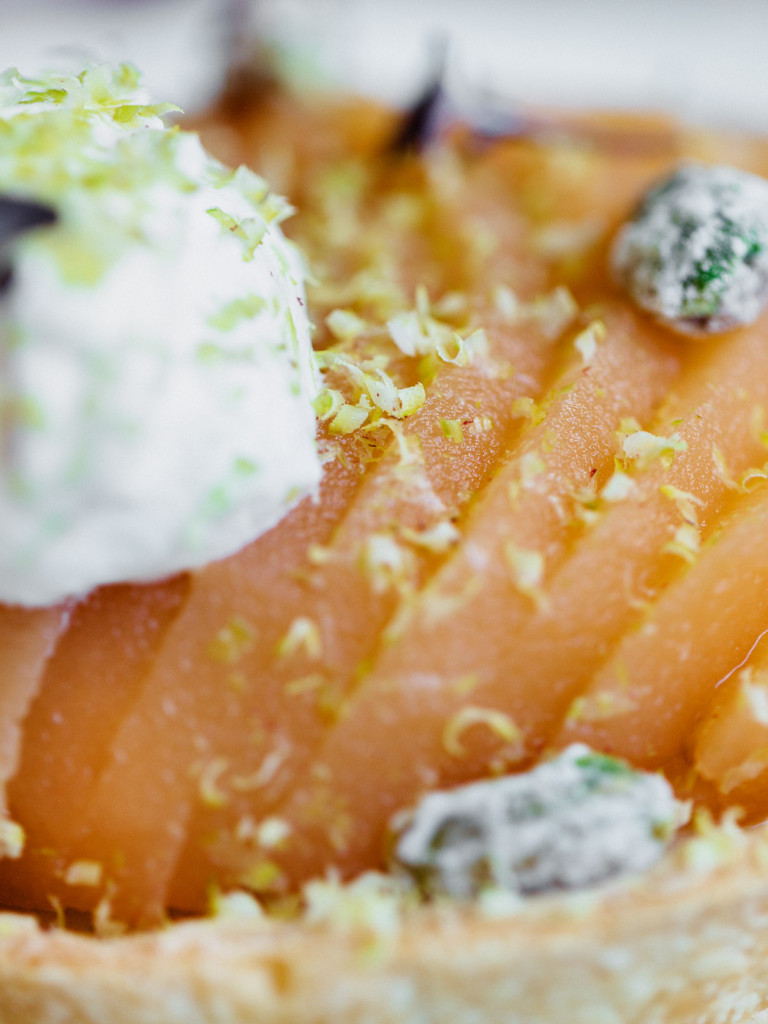El Niño has just hit Los Angeles. On Christmas Day, while it was cold here (by L.A. standards), it was 70-degrees back east. My family called my uncle in Philadelphia who said it was about the same there. This strange winter weather conundrum is something peculiar this time of year. But as I stood inside Untitled a few months ago, Union Square Hospitality Group’s latest venture with Chef Michael Anthony of Gramercy Tavern, you would think winter was around the corner. Here, a woman tells me she can’t wait for the restaurant to look like a snow globe from the outside in.
On this crisp, sunny morning, our photographer, Josh Telles, and I hop in a cab in front of our hotel in the Lower East Side and make our way to the Meatpacking District where Untitled sits under the High Line as a part of the Whitney Museum. We pull up to the curb on Gansevoort Street and unload in a hurry. As we approach Untitled’s glass exterior, we have a hushed chance to peek inside the façade and observe those who are bustling about their morning as if they aren’t being watched. There’s something comforting in observing this seeming solitude. As we walk inside, a florist is arranging a massive bouquet, laying out stems of various plants on the floor like a puzzle only she can see. As we step past her work, I’m handed a cup of coffee on a white saucer. The staff wants to make sure we’re comfortable, and I’m grateful for this dark roast that wakes me up as the sun creeps inside, half the restaurant still shrouded in shadow.

There is a table in the corner where Chef Miro Uskokovic, the pastry chef at Gramercy Tavern and Untitled, is waiting. We introduce ourselves; his smile is instantly warm and calming. His friendly demeanor is not at all how you’d imagine an established chef’s to be; luckily, the days of the reigning fear-inducing orders and insults seem to be waning and making way for a more collaborative effort—more like a team seeing a work of art to fruition. We take a seat, and conversation is easy. Time is marked on the blank wall behind us as the sun rotates the shadows like a film noir; this design element—whether intentional or not—is a nod to the seasons, something both Untitled and Gramercy Tavern bind themselves to.
Although sitting in the midst of New York City, Uskokovic grew up in a small farming town on the other side of the globe in Serbia during a time when the country was in turmoil. His parents had a farm where they would make cheese and yogurt, and they had a lot of land his father would farm. But by the time Uskokovic was 16, he had never left his hometown.
“As a kid and teenager, you’d always watch the shows and movies. I really wanted to go to America,” he tells me. “I was always leaning toward the West, although my father was always leaning toward Eastern Russia.” Soon he had a door open through a family friend—an exchange student. Her family offered him a place to stay if and when he ever made his way to the U.S.



“When I said I wanted to cross the ocean and live in America, it was a shock,” Uskokovic says. But his family allowed him to go through a high school exchange program under the condition that he lived with this family friend—in Greentown, Indiana.
Upon coming to America at 17 to finish his senior year of high school, Uskokovic had visions of vibrant metropolitan city life littered with skyscrapers. When he landed in Chicago, this seemed to be a possibility, but the further he headed toward Indiana through corn fields and pastures of cows, the more he realized he moved from one small agricultural town to another.
Ultimately, Uskokovic felt conflicted after moving to the States. “Everything here is completely different from where I grew up. There was a big battle inside me,” he says. So after graduation, he decided to move back home.
However, he realized if he wanted to make a life for himself, he would have to go back to the U.S. But his mother was soon diagnosed with cancer, and Uskokovic stayed with her until she passed away. He then decided it was time for him to go. “In those moments of grief, I promised her I would finish college and do the best I could,” he solemnly says as he sits across from me in his chef’s coat.
So he moved back to Indiana and started working at a small shop called Pastry Diva. “It was local, but wonderful,” Uskokovic says. He continues, “My mother was a wonderful baker, and I learned a lot from her about European-style desserts.” But working at this Indiana bakery was the first time he was able to learn about Americanized desserts like cakes, cupcakes and cookies. And its owner pushed Uskokovic to attend the Culinary Institute of America in New York, where he went to pursue culinary arts—the savory side of cooking. Not pastries.
From there, he landed an externship at Wallse where he studied under Chef Kurt Gutenbrunner. The Austrian restaurant is where he met acclaimed pastry and celebrity chef Johnny Iuzzini. He worked at Wallse for about a year, and rather than returning to CIA to pursue the pastry arts, he decided to pursue an internship at Jean Georges thanks to Iuzzini, where he worked at the time. Uskokovic eventually became the pastry sous chef there.
“It took awhile for me to convince him to give me a job,” Uskokovic laughs. “Johnny Iuzzini is definitely my greatest mentor. He’s the one who really taught me not just how to plate desserts beautifully, but also how to learn to balance. He’s known for that.” He also taught Uskokovic how to use different ingredients he didn’t grow up using in Serbia.



“He had me opening my mind and challenging myself more,” he continues. Uskokovic went on to become the pastry chef at Aldea, and ultimately ended up on Michael Anthony’s team at Gramercy Tavern in 2013.
“During schooling, I also met my wife, who’s from India. She taught me a lot about spices,” he says. Surely, his wife has influenced how Uskokovic combines savory spices with the sweets he concocts—a truly unique palate.
“Working with Mike really helped define who I am as a pastry chef,” he says. Perhaps the greatest influence Anthony has had has been helping Uskokovic focus on regional cooking and using local ingredients—an ethos that carries over to all Michael Anthony-influenced locations.
“One thing I’m very proud of with our pastry departments at Gramercy Tavern and Untitled is the amount of local and sustainable product we use. It’s very unique for such a big restaurant as Gramercy Tavern,” says Uskokovic. “We don’t do 50, 60 or 100 desserts. We do 600 to 700 desserts a day—and that’s just dessert.” While Gramercy Tavern and Untitled could only use local fruits and produce, all their dairy is also local—the eggs, milk, cream and butter. Even the flowers, like the ones I saw when I arrived early that morning, are local. And the small percentage of commercial flour they use, King Arthur, is still the best you can find.
You can’t talk about a pastry chef without talking about sugar, something Uskokovic uses sparingly. He continues, “I don’t think I’ve made a dessert yet that did not have a fruit component to it.” And if you’re using delicious, organic ingredients like fruit, there’s no need to add the extra sugar.
“I like to use sugar more as a seasoning rather than a main ingredient,” says Uskokovic. “I come from Eastern Europe; we don’t use the sugar packed to the level you see here or in France. When I came here, it was a little big of a shock to me to see such rich and strong desserts loaded with fat and sugar.” When creating his desserts, Uskokovic doesn’t want to head too far left or right in either direction; he would rather the flavors complement one another. “Every one of our desserts has a generous pinch of salt,” which he uses to bring out the natural sweetest and flavors of the dessert’s ingredients.
Much like how this salt complements the sugar, his job as pastry chef is to create sweets to complement the chef’s menu. “As a pastry chef, we’re like the best friend in a movie. We’re never the main lead,” he jokes. “My job is to make sure my desserts not only taste good, but match what came before that.”


“[Chef Michael Anthony] has a wonderful way with vegetables, and his cooking is very light and wonderfully balanced, so I have to make sure the desserts are as well so there is no disconnect,” Uskokovic explains. “Also, it’s very important that at the end of the meal people aren’t just full, but happy.” And content. Dessert is the period on your sentence. It’s how you end your meal. It’s how you end your day.
It’s one thing to complement the chef’s menu at only one location, but Uskokovic is essentially working with four including the Studio Café at Untitled and the Tavern and Dining Room at Gramercy Tavern. All are different demographics—which is part of the reason why Uskokovic took the position at Untitled when asked by Anthony.
“I really tried to establish a program at Gramercy Tavern that is very diverse, from having two different restaurants with two different menus, to the bread program, to the chocolate program. We allow for our cooks to have a variety of things they can learn,” he explains. When you offer diversity—and opportunity—in the kitchen, you’re more likely to build a team that is gratified by the challenge. “At Untitled we do something totally different. We went in a direction with desserts that we don’t have at Gramercy Tavern. Desserts here are more American. It’s allowed us to play with classic desserts and focus more on regional ingredients.”
“It’s a different crowd. It’s a challenge and it definitely pushes me to have a more open mind and think about our guests; maybe what they want at Gramercy Tavern isn’t what they would want here,” says Uskokovic.
Perhaps his largest challenge—and accomplishment—is the use of the same ingredients at all locations. “Even though we’re using the same combination [of ingredients], our desserts are very distinct and different, and they are specifically made for that restaurant. We never repeat desserts,” he says to me. While he might serve a butterscotch pudding with toffee popped sorghum, salted caramel sauce and pear granite at Gramercy Tavern, he might serve a sticky toffee cake with pears and chai at Untitled.
“On average, we change one dessert a week,” he says. I take a second to let that sink in. On top of changing the menu seasonally, it also changes weekly. Developing a dessert menu on that scale, with each location boasting a different point of view, is surely a feat worthy of praise.
None of this would be possible—his vision wouldn’t be possible—without the help of his team. Uskokovic has built a kitchen environment that is collaborative and respectful. And he gives his staff a chance to pitch their own recipes.


Untitled only opened in May of 2015, so they’ve just about seen a full year’s worth of seasons. Between Gramercy Tavern and Untitled, the restaurants typically offer 24 different desserts at a time; Gramercy Tavern has 13 desserts and Untitled has 11. Without the team dynamic between chef, his sous chefs and the rest of the kitchen staff working together, the menu would be impossible to execute. He has a built a collaborative environment where ideas and opinions are encouraged and fostered. Of course, all must sit down with Uskokovic and they’ll work on ideas together—consistency and continuity must be maintained.
“All of our sous chefs have contributed to the menu, as well as some cooks. I think it’s a good thing to allow cooks to do it. It’s one thing to teach them how to make things, but making things is completely different than creating things,” he says. As a testament to Uskokovic’s leadership style, these sous chefs have followed him from his time at Jean Georges, by the way. Even if only one component of their recipe ends up on the menu, it’s an encouraging morale boost for the cook and the team.
“When Dessert Professional announced I was one of their top-10 pasty chefs, I said this isn’t just my moment, this is everybody’s moment,” he says, genuinely. “You don’t get anywhere in life alone. Especially in this business.” Between all the desserts and the bread program they recently established at Gramercy Tavern, working together like a well-oiled machine is essential.

This train is in constant motion, with all it’s steel and bolts and steam working together and moving forward. For example, Uskokovic started thinking about Gramercy Tavern’s bread program a year ago when he wanted to join the Local Grain Project. “We started purchasing a lot of local grains and flours. We wanted to use these local grains, and the best way to do so is through bread. It took so long to do it because local grains aren’t as processed as regular flours, so they’re a little more difficult to work with. But I think that’s fun. It’s also kind of nerve-wracking,” he laughs. It took about six months and countless loaves of dough to figure out. This form of responsible cooking—and responsible leadership—needs to come from the top-down. Michelin-rated restaurants—restaurants others aspire to emulate—and their chefs need to set the precedent; others will follow suit. By doing so, they will establish a precedent for responsible cooking and eating, not to mention help build demand, and thus an economy, for these local mills and farms. “Everything you know about bread is forgotten. Using commercial flour is always the same,” he says. With these new textures and flavors, you are creating something new from something old. In a world of processed, bleached flour and sugar, that something new is something old.
While Michael Anthony has given Uskokovic a platform to progress as pastry chef, and to challenge himself personally, professionally and creatively (“He gave me a chance to show who I am and what I can do.”), Uskokovic does that with his own team. “The ruling by fear doesn’t lead anywhere. It always breaks at some point,” he says. “I spend more time with my cooks than I do with my family. They are my family.”
I imagine this restaurant and its staff inside the glass exterior as the snow globe. It’s a vision like a Rockwell painting, all the people working together to create an image of artistic cohesiveness. And I think of the promise Uskokovic made to his mother, and I think she would be proud watching this vignette.
Telles and I leave Untitled happy. Maybe it was the sugar from the sweets they prepared, that warm coffee on a saucer, or the conversation I had—but it provided me with sustenance during that early morning. We whisk out onto the busy streets and wander around before we need to make our way to the West Village. We have time so we decide to walk. When you have the opportunity to experience something new, why not take it?
—
Untitled
99 Gansevoort Street
New York, NY 10014







Our comments section is for members only.
Join today to gain exclusive access.